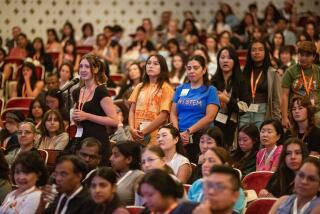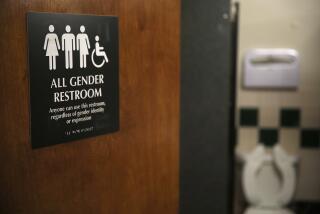Feminism looks to the horizons
“You are probably wondering why I am up here,” artist Faith Wilding said, taking her turn on a panel discussion about “Third Wave Feminisms” Saturday afternoon at CalArts. “When I was invited, I said I didn’t want to be on the history panel. I’m tired of being on the history panel. The feminist project is not over. I’ve been teaching feminism for the last 30 years and our work is still so much at the beginning, in so many ways. I’m on the endless wave, that’s all I can say.”
But she and other artists and activists had much more to say about the F-word, feminism, at the symposium staged as part of the student-organized feminist project “Exquisite Arts & Everyday Rebellions.” Encompassing lectures, film and video screenings, performances, workshops and an art show, the CalArts program is part of a nationwide feminist bonanza related to “WACK! Art and the Feminist Revolution,” a major exhibition at the Museum of Contemporary Art in Los Angeles, and the Brooklyn Museum’s Elizabeth A. Sackler Center for Feminist Art, which will open March 23.
At the symposium, two of the three panels -- “Strategies for Contemporary Feminism” and “The Personal Is Political, Revisited” -- featured gurus, such as artist Martha Rosler, CalArts professor Catherine Lord and UCLA professor Mary Kelly. But Wilding was a sort of eminence grise among younger artists on her panel.
“I wanted to practice what we teach, which is getting together with people who are not like you and do not have the same experience as you,” she said.
Moderator Theresa Masangkay, a CalArts student, opened the discussion by posing a daunting list of questions:
Is feminism for everybody?
Is third wave feminism defined by its greater inclusiveness, multiculturalism and plurality?
What is the role of gender and sexual identity in feminism today?
How do questions of racial identity factor into third wave feminism?
What is the role of feminism for women in the non-Western world?
Have the conditions of the contemporary art world changed for feminist artists?
What possibilities are opened up by cyber-feminism and Net culture?
Maria Cruz, a video artist who was born in Mexico and lives in Los Angeles, said: “The feminism that identifies me is the cultural background of my mother and my grandmother. It is not the finest feminism, but it is there.”
When she became aware of the movement, it seemed unrelated to her.
“It was something that defined white middle-class women who fought for that,” Cruz said. “While they were fighting, my grandma was working in a sweatshop or doing something else that had nothing to do with that. Feminism did not define me. It didn’t define my culture. But learning about it, in books, you find that it’s not only for white women, it’s for everyone. But it is a struggle because the information is not there.”
Chitra Ganesh, a New York-based Indian American whose drawings and installations excavate buried memories and histories, thinks of feminism as “an ideology or an ideological condition” rather than an identity. “It is important to remember the social critique that comes along with it,” she said. Stressing the importance of “a plurality of narratives” in feminist art, she said: “What has been lacking for me is a focus on personal stories without an equivalent focus on social systems that produce those experiences.”
Throughout the day, many questions went unanswered, but panelists grappled with dozens of issues, including the F-word.
“I think just like there is a multitude of feminisms, there is also a plurality of reasons why people might not want to identify themselves as feminists,” Ganesh said. “That may range from someone who may feel that this would inconveniently situate them in a market-driven economy, or it might also include a woman of color who feels that feminism is a white middle-class movement that doesn’t represent her own philosophical position or experience.”
Feminism wasn’t the only troublesome term. “Third wave” feminism loosely refers to the third generation of feminists to emerge since the 1960s, but anyone hoping to get a more precise definition must have been disappointed.
“We all agreed that we don’t actually know what third wave feminism is,” said panelist Emily Roysdon, a Los Angeles- and New York-based interdisciplinary artist, recounting a pre-panel conversation.
For Ganesh, the concept of “the waves” is “very American and a very narrow view of progress, conveying the idea that we have achieved a higher plane. Lots of other feminisms haven’t been taken into the fold.”
Feminism is gaining visibility through the Internet, the artists agreed. Various speakers publicly worried that the current rash of feminist events may turn the movement into this year’s mainstream art world trend.
But feminism hasn’t lost its embattled tone.
Midway in the discussion, Roysdon asked everyone to stand up and make a demand: “I want feminism to ...” fill in the blank. Her count of three was followed by a shouted chorus.
Wilding seized the moment. “Do we believe feminism is for everybody?” she asked, grabbing the hands of her colleagues. “Feminism is for everybody. We do, we believe it. That’s our greatest gift. This generation and the one before it.”
More to Read
The biggest entertainment stories
Get our big stories about Hollywood, film, television, music, arts, culture and more right in your inbox as soon as they publish.
You may occasionally receive promotional content from the Los Angeles Times.










